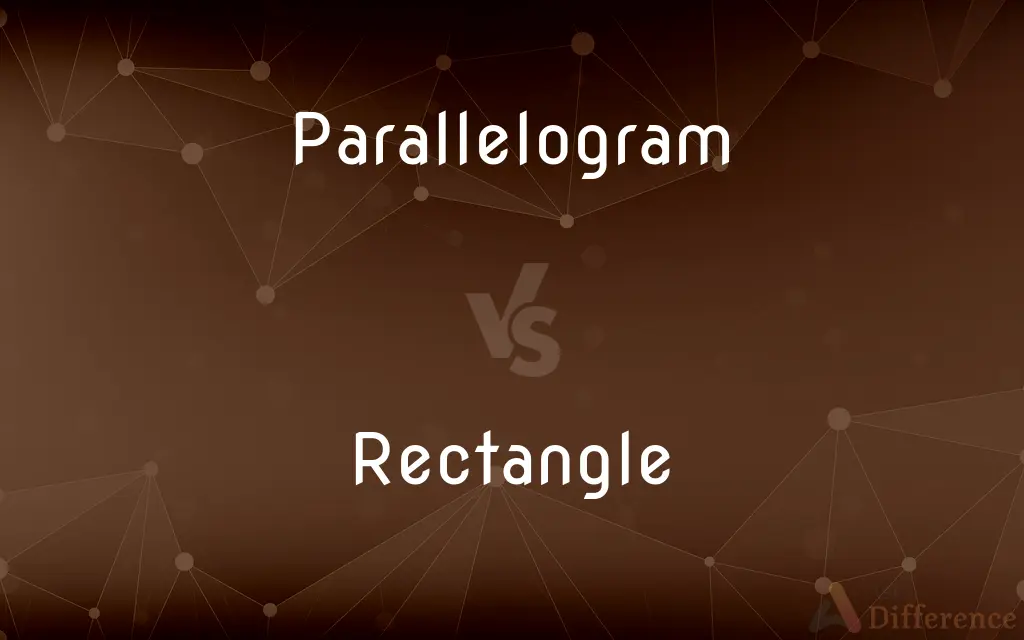Parallelogram vs. Rectangle — What's the Difference?
By Maham Liaqat & Fiza Rafique — Updated on March 20, 2024
A parallelogram is a four-sided figure with opposite sides parallel, while a rectangle is a parallelogram with right angles.

Difference Between Parallelogram and Rectangle
Table of Contents
ADVERTISEMENT
Key Differences
A parallelogram is defined by its opposite sides being parallel and equal in length, allowing for slanted shapes with no right angles. Whereas, a rectangle is a specific type of parallelogram where all interior angles are right angles (90 degrees), making it a more specific and constrained figure.
The angles in a parallelogram are supplementary (add up to 180 degrees) on each pair of opposite angles, but they are not necessarily right angles. On the other hand, every angle in a rectangle is a right angle, making the rectangle a special case of the parallelogram.
While the opposite sides of both figures are equal, the rectangle has the added characteristic of all four sides being equal if it's also a square, a further specialization. In contrast, a parallelogram's sides need not be equal in length to each other, only to their opposite side.
The diagonals of a parallelogram bisect each other but are not necessarily equal in length or perpendicular. In contrast, the diagonals of a rectangle are equal in length, bisect each other, and also bisect the angles at the vertices they connect.
Area calculation for both shapes involves the base and height, but due to the right angles in a rectangle, any side can serve as the base, simplifying calculations. For a parallelogram, the height must be perpendicular to the base, which may not be as straightforward to determine.
ADVERTISEMENT
Comparison Chart
Definition
A quadrilateral with opposite sides parallel.
A parallelogram with four right angles.
Angles
Opposite angles are equal; consecutive angles are supplementary.
All angles are right angles (90 degrees).
Sides
Opposite sides are equal and parallel.
All sides are equal in pairs, and all angles are equal.
Diagonals
Bisect each other but are not necessarily equal or perpendicular.
Are equal, bisect each other, and bisect the angles.
Area Formula
Base×Height
Length×Width
Compare with Definitions
Parallelogram
A quadrilateral with two pairs of parallel sides.
The shape of a skewed picture frame is a parallelogram.
Rectangle
A parallelogram with four right angles.
Most books and screens have a rectangular shape.
Parallelogram
Opposite angles are equal.
In a parallelogram, if one angle is 60 degrees, the opposite angle is also 60 degrees.
Rectangle
Each interior angle is 90 degrees.
A rectangle's corners are all right angles, making it a common shape in architecture.
Parallelogram
Opposite sides are of equal length.
A parallelogram's opposite sides maintain equal lengths despite its slant.
Rectangle
Equal in length and bisect each other.
The diagonals of a rectangle are congruent and split each other into equal parts.
Parallelogram
Bisect each other but not necessarily equal.
The diagonals in a parallelogram intersect at their midpoints.
Rectangle
Opposite sides are equal and parallel.
In a rectangle, both pairs of opposite sides are the same length.
Parallelogram
Calculated using base times height.
The area of a parallelogram is found by multiplying the base by the perpendicular height.
Rectangle
Length times width.
To find a rectangle's area, multiply its length by its width.
Parallelogram
In Euclidean geometry, a parallelogram is a simple (non-self-intersecting) quadrilateral with two pairs of parallel sides. The opposite or facing sides of a parallelogram are of equal length and the opposite angles of a parallelogram are of equal measure.
Rectangle
In Euclidean plane geometry, a rectangle is a quadrilateral with four right angles. It can also be defined as: an equiangular quadrilateral, since equiangular means that all of its angles are equal (360°/4 = 90°); or a parallelogram containing a right angle.
Parallelogram
A four-sided plane figure with opposite sides parallel.
Rectangle
A plane figure with four straight sides and four right angles, especially one with unequal adjacent sides, in contrast to a square.
Parallelogram
(geometry) A convex quadrilateral in which each pair of opposite edges are parallel and of equal length.
Rectangle
A four-sided plane figure with four right angles.
Parallelogram
Either of two rectangular areas (respectively the large parallelogram and the small parallelogram) abutting the goal line in front of the goal. (Since 1986 officially named the large rectangle and small rectangle, though the older names are still occasionally used.)
Rectangle
(geometry) Any quadrilateral having opposing sides parallel and four right angles.
Parallelogram
A right-lined quadrilateral figure, whose opposite sides are parallel, and consequently equal; - sometimes restricted in popular usage to a rectangle, or quadrilateral figure which is longer than it is broad, and with right angles.
Rectangle
(nontechnical) Such a quadrilateral that is oblong (longer than it is wide): one that is not regular (equilateral), that is, any except a square.
Parallelogram
A quadrilateral whose opposite sides are both parallel and equal in length
Rectangle
A four-sided figure having only right angles; a right-angled parallelogram.
Rectangle
Rectangular.
Rectangle
A parallelogram with four right angles
Common Curiosities
How do you calculate the area of a parallelogram and a rectangle?
Both use the base times height formula, but in a rectangle, any side can serve as the base due to the right angles.
What is a special case of both a parallelogram and a rectangle?
A square is a special case that qualifies as both a parallelogram and a rectangle, with the addition of all sides being equal.
What makes a parallelogram different from a rectangle?
A parallelogram has parallel opposite sides with no requirement for right angles, whereas a rectangle must have four right angles.
Can a rectangle be a parallelogram?
Yes, a rectangle is a specific type of parallelogram with right angles.
Are the diagonals of a parallelogram always equal?
No, not necessarily. The diagonals of a parallelogram bisect each other but are not required to be equal, unlike in a rectangle.
Is it possible for a parallelogram to have right angles?
Yes, if a parallelogram has right angles, it is specifically called a rectangle.
Can the diagonals of a rectangle be perpendicular?
No, the diagonals of a rectangle are equal and bisect each other but do not form right angles unless the rectangle is a square.
Are all four sides of a parallelogram always equal?
No, only the opposite sides need to be equal. If all four sides are equal, the parallelogram is also a rhombus.
Can a parallelogram be transformed into a rectangle?
Yes, by adjusting the angles to make them 90 degrees, a parallelogram can become a rectangle.
How do the practical applications of parallelograms and rectangles differ?
Rectangles are widely used in architecture, design, and everyday objects due to their right angles, while parallelograms find applications in engineering and mechanics where angled forces and movements are involved.
How do the properties of diagonals differ between parallelograms and rectangles?
In a parallelogram, diagonals bisect each other but are not equal. In a rectangle, they are equal, bisect each other, and bisect the angles.
Do parallelograms and rectangles have the same symmetry properties?
No, rectangles have more symmetry due to their right angles and equal diagonals. Parallelograms only have line symmetry if they are also rectangles or rhombi.
Why is a square considered both a parallelogram and a rectangle?
Because it has parallel opposite sides (parallelogram) and four right angles (rectangle), with the addition of all sides being equal.
What geometric properties do parallelograms and rectangles share?
Both have parallel opposite sides and equal opposite sides. The diagonals bisect each other in both shapes.
How does the presence of right angles in a rectangle affect its use in real life?
The right angles make rectangles very useful in building and design, providing stability and a familiar reference for measurements.
Share Your Discovery

Previous Comparison
Cocelebrant vs. Celebrant
Next Comparison
Metatextual vs. IntertextualAuthor Spotlight
Written by
Maham LiaqatCo-written by
Fiza RafiqueFiza Rafique is a skilled content writer at AskDifference.com, where she meticulously refines and enhances written pieces. Drawing from her vast editorial expertise, Fiza ensures clarity, accuracy, and precision in every article. Passionate about language, she continually seeks to elevate the quality of content for readers worldwide.















































